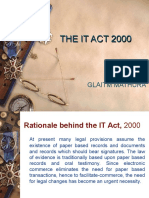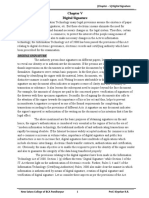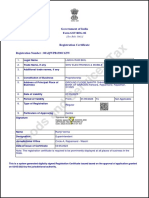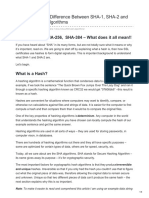IT Act Simplified
IT Act Simplified
Uploaded by
Ranjeet TehraCopyright:
Available Formats
IT Act Simplified
IT Act Simplified
Uploaded by
Ranjeet TehraCopyright
Available Formats
Share this document
Did you find this document useful?
Is this content inappropriate?
Copyright:
Available Formats
IT Act Simplified
IT Act Simplified
Uploaded by
Ranjeet TehraCopyright:
Available Formats
(t) "electronic record" means data, record or data generated, image or sound stored, received or sent in an electronic form
or micro film or computer generated micro fiche; o) "data" means a representation of information, knowledge, facts, concepts or instructions which are being prepared or have been prepared in a formalised manner, and is intended to be processed, is being processed or has been processed in a computer system or computer network, and may be in any form (including computer printouts magnetic or optical storage media, punched cards, punched tapes) or stored internally in the memory of the computer; 17. Appointment of Controller and other officers. (1) The Central Government may, by notification in the Official Gazette, appoint a Controller of Certifying Authorities for the purposes of this Act and may also by the same or subsequent notification appoint such number of Deputy Controllers and Assistant Controllers as it deems fit. (2) The Controller shall discharge his functions under this Act subject to the general control and directions of the Central Government. (3) The Deputy Controllers and Assistant Controllers shall perform the functions assigned to them by the Controller under the general superintendence and control of the Controller. (4) The qualifications, experience and terms and conditions of service of Controller, Deputy Controllers and Assistant Controllers shall be such as may be prescribed by the Central Government. (5) The Head Office and Branch Office of the office of the Controller shall be at such places as the Central Government may specify, and these may be established at such places as the Central Government may think fit. (6) There shall be a seal of the Office of the Controller. 18. Functions of Controller. The Controller may perform all or any of the following functions, namely: (a) exercising supervision over the activities of the Certifying Authorities; (b) certifying public keys of the Certifying Authorities; (c) laying down the standards to be maintained by the Certifying Authorities; (d) specifying the qualifications and experience which employees of the Certifying Authorities should possess; (e) specifying the conditions subject to which the Certifying Authorities shall conduct their business; (f) specifying the contents of written, printed or visual materials and advertisements that may be distributed or used in respect of a Digital Signature Certificate and the public key; (g) specifying the form and content of a Digital Signature Certificate and the key, (h) specifying the form and manner in which accounts shall be maintained by the Certifying Authorities; (i) specifying the terms and conditions subject to which auditors may be appointed and the remuneration to be paid to them; (j) facilitating the establishment of any electronic system by a Certifying Authority either solely or jointly with other Certifying Authorities and regulation of such systems;
DIGITAL SIGNATURE 3. Authentication of electronic records. (1) Subject to the provisions of this section any subscriber may authenticate an electronic record by affixing his digital signature. (2) The authentication of the electronic record shall be effected by the use of asymmetric crypto system and hash function which envelop and transform the initial electronic record into another electronic record. Explanation.For the purposes of this sub-section, "hash function" means an algorithm mapping or translation of one sequence of bits into another, generally smaller, set known'as "hash result" such that an electronic record yields the same hash result every time the algorithm is executed with the same electronic record as its input making it computationally infeasible (3) Any person by the use of a public key of the subscriber can verify the electronic record. (4) The private key and the public key are unique to the subscriber and constitute a functioning key pair. ELECTRONIC GOVERNANCE 4. Legal recognition of electronic records. Where any law provides that information or any other matter shall be in writing or in the typewritten or printed form, then, notwithstanding anything contained in such law, such requirement shall be deemed to have been satisfied if such information or matter is (a) rendered or made available in an electronic form; and (b) accessible so as to be usable for a subsequent reference. 5. Legal recognition of digital signatures. Where any law provides that information or any other matter shall be authenticated by affixing the signature or any document shall be signed or bear the signature of any person (hen, notwithstanding anything contained in such law, such requirement shall be deemed to have been satisfied, if such information or matter is authenticated by means of digital signature affixed in such manner as may be prescribed by the Central Government. Explanation.For the purposes of this section, "signed", with its grammatical variations and cognate expressions, shall, with reference to a person, mean affixing of his hand written signature or any mark on any document and the expression "signature" shall be construed accordingly.
You might also like
- LBS License Application FormDocument2 pagesLBS License Application FormAmith Unnimadhavan U63% (8)
- ICT - ACT-2006: Aminul Islam Niloy Saim Hasan Nahid Fahim Ahammed FirozDocument12 pagesICT - ACT-2006: Aminul Islam Niloy Saim Hasan Nahid Fahim Ahammed FirozFahim AhammedNo ratings yet
- M ITADocument31 pagesM ITAvishalz902No ratings yet
- "Adjudicating Officer" Means An Adjudicating Officer Appointed UnderDocument5 pages"Adjudicating Officer" Means An Adjudicating Officer Appointed UnderSudip PatraNo ratings yet
- Explanation.-For The Purposes of This Section, "Signed", With Its Grammatical Variations and CognateDocument6 pagesExplanation.-For The Purposes of This Section, "Signed", With Its Grammatical Variations and CognateRaj Kishor YadavNo ratings yet
- Information Technology Act, 2000: Objects of The ActDocument9 pagesInformation Technology Act, 2000: Objects of The ActShivani KanwarNo ratings yet
- IT ACT-notesDocument5 pagesIT ACT-notesPrerna SharmaNo ratings yet
- It Act 2000Document34 pagesIt Act 2000kushagrakul100% (1)
- 2 DIGITAL SIGNATURE and INFORMATION TECHNOLOGY LAWDocument27 pages2 DIGITAL SIGNATURE and INFORMATION TECHNOLOGY LAWShazaf KhanNo ratings yet
- Information Techonology ActDocument18 pagesInformation Techonology ActRajit Kumar KrishnaNo ratings yet
- The Information Technology ActDocument15 pagesThe Information Technology ActRohan SinghNo ratings yet
- IT CA English Final 2020 06 06Document19 pagesIT CA English Final 2020 06 06Ellis AdaNo ratings yet
- Information Technology ActDocument19 pagesInformation Technology ActVeenus MasihNo ratings yet
- IT Act 2000: Presented By: Siddharth Gandhi Sneha ChitoorDocument52 pagesIT Act 2000: Presented By: Siddharth Gandhi Sneha ChitoorNeo FoxNo ratings yet
- The Information Technology Act, 2000Document13 pagesThe Information Technology Act, 2000AishwaryaSushantNo ratings yet
- Regulation of Certifying Authorities Date: 25-3-20Document3 pagesRegulation of Certifying Authorities Date: 25-3-20sanjeevNo ratings yet
- DR Rachna Mahalwala - B.Com Ist Yr Business Law Regulation of Certifying AuthoritiesDocument3 pagesDR Rachna Mahalwala - B.Com Ist Yr Business Law Regulation of Certifying AuthoritiesSudhanshu PandeyNo ratings yet
- The Information Technology Act, 2000Document50 pagesThe Information Technology Act, 2000senanmanuNo ratings yet
- Module-IV-Corporate LawsDocument18 pagesModule-IV-Corporate LawsjamnabengangwaniNo ratings yet
- Cyber LawDocument1 pageCyber LawRabby NawabNo ratings yet
- Digital Signature Certifying Authority-CryptographyDocument12 pagesDigital Signature Certifying Authority-CryptographyMadhumati ExpressNo ratings yet
- Information Technology Act, 2000: by Pranjal SrivastavaDocument21 pagesInformation Technology Act, 2000: by Pranjal SrivastavaNishant AwasthiNo ratings yet
- Information Technology Act 2000-An: BBM Ivth SemDocument85 pagesInformation Technology Act 2000-An: BBM Ivth SemShruthi RjNo ratings yet
- 2020 Interim Rules On Remote Notarization of Paper Documents 2020 Interim Rules On Remote Notarization of Paper Documents 2020-07-14Document13 pages2020 Interim Rules On Remote Notarization of Paper Documents 2020 Interim Rules On Remote Notarization of Paper Documents 2020-07-14vincent gianNo ratings yet
- Itact 2000Document25 pagesItact 2000tripti_0785No ratings yet
- Information Technolog ActDocument2 pagesInformation Technolog Actnav16.gNo ratings yet
- 2020 Interim Rules On Remote Notarization of Paper Documents 2020 Interim Rules On Remote Notarization of Paper Documents 2020-07-14Document13 pages2020 Interim Rules On Remote Notarization of Paper Documents 2020 Interim Rules On Remote Notarization of Paper Documents 2020-07-14Raymond RodisNo ratings yet
- Rules On Electronic Evidence Am 01Document4 pagesRules On Electronic Evidence Am 01redenbidedNo ratings yet
- Cyber Authorities NotesDocument12 pagesCyber Authorities NotesJananiNo ratings yet
- EvidenceDocument6 pagesEvidenceattymanekaNo ratings yet
- Electronic EvidenceDocument9 pagesElectronic EvidenceAe-cha Nae GukNo ratings yet
- Unit 6 Information Technology Act 2000: StructureDocument16 pagesUnit 6 Information Technology Act 2000: StructuregaardiNo ratings yet
- Info Tech ActDocument65 pagesInfo Tech ActvimalrmgitNo ratings yet
- Information Technology ActDocument6 pagesInformation Technology ActBatchu VarshiniNo ratings yet
- Electronic Transaction Act, 2063Document9 pagesElectronic Transaction Act, 2063Manzil ShresthaNo ratings yet
- Information Technology Act 2000 An Overview SethassociatespptDocument85 pagesInformation Technology Act 2000 An Overview Sethassociatespptgeetainderhanda4430No ratings yet
- Information Technology Act 2000Document85 pagesInformation Technology Act 2000Dhiraj AhujaNo ratings yet
- IT Act ProjectDocument13 pagesIT Act ProjectAnam UsmaniNo ratings yet
- Information Technology Act 2000-AnDocument86 pagesInformation Technology Act 2000-AnGaurav SinghNo ratings yet
- SigningHub and FDA 21 CFR 11 ComplianceDocument7 pagesSigningHub and FDA 21 CFR 11 ComplianceHarisH YNo ratings yet
- ETODocument25 pagesETOAltaf SheikhNo ratings yet
- Joint Department Admin Order No. 2Document8 pagesJoint Department Admin Order No. 2business permits and licenses div.No ratings yet
- Electronic Evidence - Smart NotesDocument30 pagesElectronic Evidence - Smart NotesAnnai SagayamNo ratings yet
- Unit 2Document34 pagesUnit 2tusharkhatriNo ratings yet
- Lecture Delivered During Training Programme For District Judges Under The Aegis of 13 Finance Commission Grant at Tamil Nadu State Judicial Academy On 26.03.2011Document17 pagesLecture Delivered During Training Programme For District Judges Under The Aegis of 13 Finance Commission Grant at Tamil Nadu State Judicial Academy On 26.03.2011Ashish RajNo ratings yet
- Regulation of Certifying AuthoritiesDocument20 pagesRegulation of Certifying AuthoritiesAparna MukherjeeNo ratings yet
- CH 10 - Information Technology Act, 2000Document29 pagesCH 10 - Information Technology Act, 2000Kinish ShahNo ratings yet
- Digital SignatureDocument13 pagesDigital SignatureRohan KirpekarNo ratings yet
- Information Technology Act 2000Document41 pagesInformation Technology Act 2000siddharth devnaniNo ratings yet
- Sanjana Mittal Cyber AuthoritiesDocument8 pagesSanjana Mittal Cyber AuthoritiesDivyankar SinghNo ratings yet
- Legal Status of Dematerialized Bills of Lading in India.Document5 pagesLegal Status of Dematerialized Bills of Lading in India.Syam Kumar V.M.No ratings yet
- The Electronic Transactions Act 2000: (Proclamation No. 7 of 2001)Document28 pagesThe Electronic Transactions Act 2000: (Proclamation No. 7 of 2001)Liam charlesNo ratings yet
- COA Circular 2021-006 (Re Electronic Signatures)Document5 pagesCOA Circular 2021-006 (Re Electronic Signatures)Fam MedinaNo ratings yet
- Implementing Rules and Regulations On Electronic SignaturesDocument10 pagesImplementing Rules and Regulations On Electronic Signaturesdjdee10No ratings yet
- OVERVIEW OF INFORMATION TECHNOLOGY ACT 2000 - Huzaifa SalimDocument9 pagesOVERVIEW OF INFORMATION TECHNOLOGY ACT 2000 - Huzaifa SalimHuzaifa SalimNo ratings yet
- 30 Oct - EviDocument4 pages30 Oct - EviSakshi JainNo ratings yet
- 12 SCR200309111103031717Document10 pages12 SCR200309111103031717Arya SenNo ratings yet
- CISA Exam-Testing Concept-Elements of PKI i.e CA/RA/CRL/CPS (Domain-5)From EverandCISA Exam-Testing Concept-Elements of PKI i.e CA/RA/CRL/CPS (Domain-5)Rating: 4 out of 5 stars4/5 (2)
- Federal Rules of Civil Procedure: Hyperlinked, #2From EverandFederal Rules of Civil Procedure: Hyperlinked, #2Rating: 5 out of 5 stars5/5 (1)
- Shiv GSTDocument3 pagesShiv GSTGovind SharmaNo ratings yet
- Acrobat Signature Permissions KeyDocument1 pageAcrobat Signature Permissions KeyMcKalkin RobertNo ratings yet
- E-Tender DOCUMENT: TH TH THDocument32 pagesE-Tender DOCUMENT: TH TH THpitamberNo ratings yet
- Cloudsearch DGDocument330 pagesCloudsearch DGclaireNo ratings yet
- Lambton College of Applied Arts and Technology Official Document Cover PageDocument4 pagesLambton College of Applied Arts and Technology Official Document Cover PageAlbin GeorgeNo ratings yet
- Crypt in Smart CardsDocument8 pagesCrypt in Smart CardsLeela Anusha BNo ratings yet
- Skrill Automated Payments Interface GuideDocument34 pagesSkrill Automated Payments Interface GuidetikerinfoNo ratings yet
- Experiment No-9: Name: Rhugved Satardekar Roll No: 17141208Document8 pagesExperiment No-9: Name: Rhugved Satardekar Roll No: 17141208Pallavi BhartiNo ratings yet
- Rsa Securitys Official Guide To Cryptography.Document449 pagesRsa Securitys Official Guide To Cryptography.Nikola NojicNo ratings yet
- GXChain WhitePaper v3.0 ENDocument42 pagesGXChain WhitePaper v3.0 ENRZW RNo ratings yet
- Summer Internship ReportDocument35 pagesSummer Internship ReportJasmita WaliaNo ratings yet
- Digital Signature: Presented by K.ANITHA (19065) T.DIVYA (19074) T.PAVAN (19082) P.Venu Gopal Reddy (19104)Document19 pagesDigital Signature: Presented by K.ANITHA (19065) T.DIVYA (19074) T.PAVAN (19082) P.Venu Gopal Reddy (19104)Divya TammineediNo ratings yet
- (Ebook German) Asterix 07 - Asterix Und Die GotenDocument45 pages(Ebook German) Asterix 07 - Asterix Und Die Gotenpelu100092% (13)
- Electronic Mail SecurityDocument20 pagesElectronic Mail SecurityAayatKhanNo ratings yet
- CISSPDocument129 pagesCISSPNishanth Kashyap100% (2)
- Cryptography: Netprog: Cryptgraphy 1Document26 pagesCryptography: Netprog: Cryptgraphy 1harsh_cycloneNo ratings yet
- RMA Planning Guide Mar08Document67 pagesRMA Planning Guide Mar08abdala88No ratings yet
- GST RC Laxmi Communication ChetanDocument3 pagesGST RC Laxmi Communication ChetanNagpal ComputersNo ratings yet
- 7069 2016 CertificateDocument1 page7069 2016 CertificateRudra SahuNo ratings yet
- Can Digital Signatures Be Copied From One DocumentDocument52 pagesCan Digital Signatures Be Copied From One DocumentShravan K G100% (1)
- Digigov - 2024-05-30T115148.710Document3 pagesDigigov - 2024-05-30T115148.710visitsheetrajkotNo ratings yet
- Certifying AuthorityDocument25 pagesCertifying AuthorityMushtaq Ahmad100% (1)
- SSM 2Document7 pagesSSM 2steven yapNo ratings yet
- Legal Aspects of Business Subject Code 554 JDocument46 pagesLegal Aspects of Business Subject Code 554 Jkundan kumarNo ratings yet
- Re-Hashed The Difference Between SHA-1 SHA-2 and SHA-256 Hash AlgorithmsDocument6 pagesRe-Hashed The Difference Between SHA-1 SHA-2 and SHA-256 Hash AlgorithmsFunto TofunNo ratings yet
- Progress in Multivariate Cryptography Systematic ReviewDocument34 pagesProgress in Multivariate Cryptography Systematic ReviewFai ShararNo ratings yet
- LTE ENodeB Security Networking and Data Configuration-20100331-A-1.0Document35 pagesLTE ENodeB Security Networking and Data Configuration-20100331-A-1.0alikaiser88No ratings yet
- CMA Tax Bulletin 73Document96 pagesCMA Tax Bulletin 73ABC 123No ratings yet
- Gujarat Technological University: Page 1 of 6Document6 pagesGujarat Technological University: Page 1 of 6Parshw PatelNo ratings yet

























































































